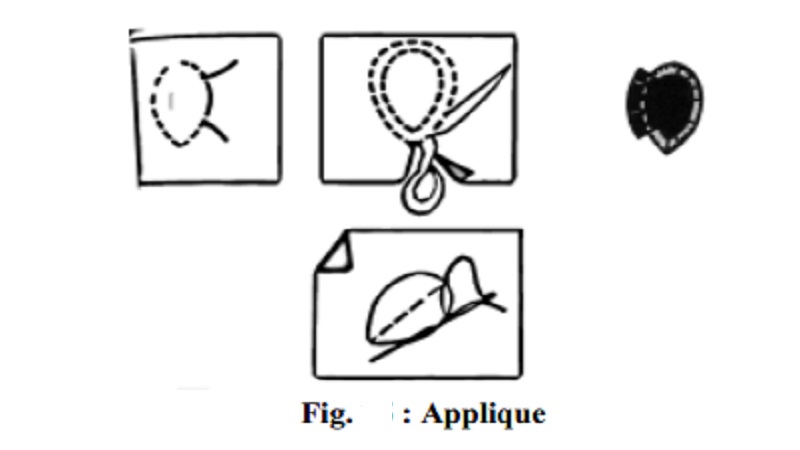Chapter: 11th 12th std standard Home Science Maintain Basic Knowledge for family life Higher secondary school College
Applique

Applique
Applique work is basically a sewing craft, and
so it calls for much the same tools and supplies. Fabrics are ofcourse
essential, but not necessarily in great quantities scraps and pieces are
usually adequate for a small project.
To stitch an appliqué in place, use an all purpose sewing thread. For
additional decorative stitching, you go to embroidery floss or pearl cotton.
Sharps are a type of medium-length needle excellent for hand stitching. Another
essential tool in appliqué work is a sharp pair of scissors. Other useful
sewing supplies include fine straight pins for holding appliqués in place, and
a dressmaker's marking pencil. Frames, heavy tracing paper and coloured
construction paper are helpful to have for copying or cutting out designs.
Transferring designs
Before transferring a design, cut background fabric, which may be a
patchwork block or even a garment section, to desired size. In order to center
the design accurately, mark lengthwise and crosswise centerlines through the
background piece. The centerlines are especially helpful in patch work because
they enable you to position the appliqué in exactly the same spot for each of
the block involved. The placement of single appliqués is not always marked on
the background if the centerlines will serve adequately as guides. For greater
accuracy, however, placement marking is recommended.
Cutting appliques
The first step, if you will be cutting several appliqués, is to assemble
your fabric scraps and decide which ones will be used for each piece. Try to
achieve a balance of colours as well as a balance of prints, solids and
textures. If the fabrics you have selected have a dominant print or weave,
consider carefully how you want that print or weave placed on each appliqué piece.
For eg, if a fabric is striped, it can be cut so that the stripes run
vertically, horizontally, diagonally or a combination of these. In making each
decision, consider the surrounding fabrics as well.
Pin template to right side of fabric. Trace around pattern with
dressmaker's pencil. Remove template. Mark a 1/8' to 1/4' seam allowance
outside the drawn seamline, use the wider seam allowance on fabrics that are
loosely woven.
Cut appliqué outside of marked lines so that an ample fabric width is
left. This wider margin will make it easier for you to stay stitch in the next
step.
To facilitate turning under of edges, stay stitch a hair outside inner
marked seamline. Set sewing machine to 12-15 stitches per inch.
Trim margin by cutting appliqué on outer marked lines as shown. Clip
seam allowances around curves and corners so edges can be properly turned.
Securing appliqués by
hand
An appliqué can be hand-stitched in place by
either of the two method. The first method, though somewhat time consuming, is
recommended for beginners. It calls for an additional basting step that holds
the turned-under seam allowance in position, making it less awkward to secure
the appliqué to the background. The second method skips initial basting of
edges instead the appliqué is pinned in place, and the edges turned and
stitched.
To secure the appliqué a fine slip-stitch is
recommended, it holds the appliqué dependably and is almost invisible when
carefully worked. An overhand stitch, though not invisible, should be used in
small areas that tend to fray. Embroidery stitches such as the running stitch
and the cross stitch can also be used to fasten down as appliqué. Remember that
these are decorative stitches, meant to be seen, they will become part of the
design.
To slip stitch
Work from right to left. Bring needle and thread
through folded edge of appliqué. Pick up a thread or two from background fabric
just opposite, then insert needle back into folded edge and slip it through
fold about 1/8', bring needle out and pull thread through.
Continue
this way to end.
Decorating appliques
Decorating with embroidery can greatly enhance the over all look of any
appliqué design. Even though you may not deliberately plan on any such
embellishment, possibilities may occur to you, after your appliqué is
completed. There is a vast array of embroidery stitches to choose from, you can
use them to work out original details or special effects, or simply as a
decorative means of securing the appliqué in place.
Related Topics